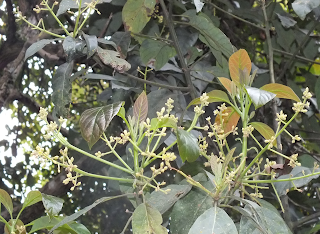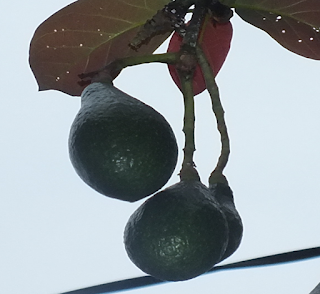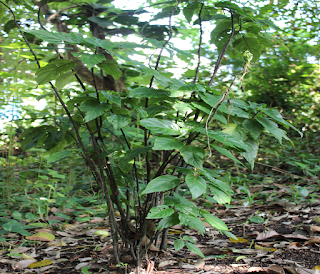Persea americana Mill.
Persea
americana Mill.
(This plant is belongs to the family Lauraceae)
Persea americana
(alpukat)
(Hidayat T., 2017)
Classification:
Kingdom : Plantae
Divisio :
Magnoliophyta
Classis :
Magnoliopsida
Order :
Laurales
Familia : Lauraceae
Genus :
Persea
Species : Persea americana
Description:
Avocado,
also called alligator pear, fruit of Persea americana of the family Lauraceae,
a tree native to the Western Hemisphere from Mexico south to the Andean
regions. Avocado fruits have greenish or yellowish flesh with a buttery
consistency and a rich, nutty flavour. They are often eaten in salads, and in
many parts of the world they are eaten as a dessert. Mashed avocado is the
principal ingredient of guacamole, a characteristic sauce in Mexican cuisine.
Avocados provide thiamin, riboflavin, and vitamin A, and in some varieties the
flesh contains as much as 25 percent unsaturated oil.
Avocado
trees can be tall or spreading, and they have elliptic to egg-shaped leaves
that are 10–30 cm (4–12 inches) in length. The small greenish flowers are borne
in dense inflorescences and lack true petals. The flowers have nine stamens,
arranged in three series, and a one-celled ovary. Interestingly, there are two
types of avocado flowers, A and B, depending on the cultivar. These flowers are
dichogamous (male and female parts mature separately), and each flower opens
only twice. Type A flowers are functionally female in the morning, close at
midday, and then reopen as functionally male in the afternoon of the following
day. Type B flowers are functionally female in the afternoon, close in the
evening, and then reopen the following morning as functionally male. When the
two flower types are grown together, this temporal overlap of mature male and
female parts encourages cross-pollination and, thus, greater fruit production.
The
fruit is exceedingly variable in size, no larger than a hen’s egg in certain
Mexican races and sometimes weighing 1–2 kg (2–4 pounds) in other races. The
form varies from round to pear-shaped with a long, slender neck, and the colour
ranges from green to dark purple. Botanically, the fruit is a berry and
features a single large round seed with two cotyledons. The fruit’s outer skin
is sometimes no thicker than that of an apple and sometimes is coarse and woody
in texture.
Avocados
were first domesticated in tropical America, where they were cultivated as
individual seedling trees before the Spanish conquest. The plants did not
receive serious horticultural attention until about 1900, when horticulturists
found that production of grafted trees was simple and allowed perpetuation of
superior seedlings and the establishment of orchards. Flourishing avocado
industries have since developed around the world in suitable climates. Mexico,
Chile, the Dominican Republic, Indonesia, and Colombia were the top producers
worldwide in 2011. The fruits are also grown commercially in Florida,
California, Hawaii, South Africa, Brazil, and Australia, as well as on some
Pacific islands and in several Mediterranean countries, including Israel.
Horticulturally,
avocados are divided into the Mexican (Persea americana variety drymifolia),
West Indian (P. americana variety americana), and Guatemalan (P. americana
variety guatemalensis) races, with more than 1,000 cultivars between them. The
Mexican race is native to Mexico and is characterized by the aniselike odour of
the leaves and by small (weighing 90–240 grams [3–8 ounces]), thin-skinned
fruits of rich flavour and excellent quality. Mexican avocados are the
hardiest, growing in regions too cold for other types. The Guatemalan, native
to the highlands of Central America, is slightly less frost-resistant than the
Mexican and produces fruits of medium to large size (240–1,000 grams),
characterized by thick woody skins and a ripening season different from that of
the others. Cultivation of the West Indian, the most tropical in character, is
limited in the United States to southern Florida. Hass avocado, the most
popular cultivar in the United States, is a Mexican-Guatemalan hybrid.
Spot Character:
Fruits
are flesh and green-skinned, that may be pear-egg-, and spherical shaped
Benefit:
Edible
plant
Distribution:
Mexico,
Central America, Asia
Location
Zone
1 of UPI Botanical Garden
Fruit of Persea americana
(Hidayat T., 2017)
REFERENCES
Hidayat, T. dan Abdurahman, E. (2017). Keanekaragaman Tumbuhan Biji di Kampus UPI Bandung. Bandung: UPI Press




Komentar
Posting Komentar